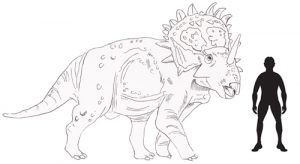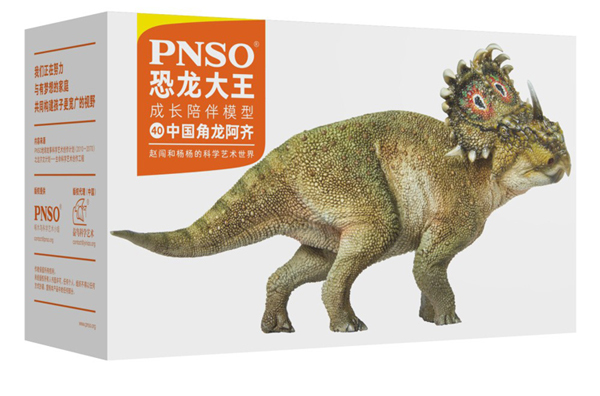Sinoceratops zhuchengensis – Rewriting the History of the Horned Dinosaurs
A new genus of horned dinosaur has been announced by scientists from the Chinese Academy of Sciences. This new genus of ceratopsian (horned dinosaur) has characteristics of both the short-frilled Centrosaurinae and the long-frilled Chasmosaurinae. It could lead to a re-think of the entire horned dinosaur family and this discovery sheds further light on the migration of ceratopsians across northern latitudes.
Horned Dinosaur
The fossils were excavated in January 2008 in Zhucheng City in the eastern part of Shandong Province, a province in the far eastern part of China. In a statement from the Chinese Academy of Sciences, this new genus Sinoceratops zhuchengensis – (the name means “Chinese Horned Face from Zhucheng City”) was formally introduced to the press at a special media briefing. This area of China is already well-known for the range of Late Cretaceous dinosaur fossils, including hadrosaurs and tyrannosaurids, but the discovery of a ceratopsian with a huge, neck shield resembling the horned dinosaurs of North America is an exceptional event.
Commenting on the discovery, Research Fellow Xu Xing of the Institute of Vertebrate Palaeontology and Palaeoanthropology (Chinese Academy of Sciences) stated:
“It [Sinoceratops] was identified only quite recently. Its skull is at least 180 cm long and 105 cm wide. It has a 30 cm long horn on its face and at least 10 crooked, smaller horns on the top of its head.”
It was Xu Xing and his team who were given the responsibility of formally naming and describing this new dinosaur, one that has characteristics of both the main types of ceratopsian groups. Sinoceratops has a large single horn over the nose, a characteristic of the centrosaurine type of horned dinosaur, but Sinoceratops also has a large neck frill a characteristic associated with the other group of horned dinosaurs, the chasmosaurines.
An Artist’s Impression of Sinoceratops zhuchengensis (Scale Drawing)
Picture credit: Everything Dinosaur.
Resembling the North American Centrosaurus, a horned dinosaur whose numerous remains have been found in many bonebeds in Alberta, dating from the Campanian faunal stage of the Late Cretaceous, Sinoceratops has been classified as a basal centrosaurine, but it is much larger than other members of this horned dinosaur family.
It is closer in size to the basal Chasmosaurinae. It is the first long-frilled genus of horned dinosaur to be discovered in China. Prior to the discovery of Sinoceratops, the ceratopsians with large neck-frills were exclusively restricted to western North America. This new dinosaur genus has implications for the current theories on the evolution of ceratopsians and it has changed the views held by scientists on the biogeographical distribution of Dinosauria genera.
Sinoceratops zhuchengensis
The basal ceratopsians, animals such as Protoceratops, Bagaceratops and Breviceratops are known from fossil finds from Asia. It seems likely that the horned dinosaur clade evolved in Asia, but some time after these animals evolved they migrated eastwards across Asian/North American land bridges.
The North American migrants diverged into two main types, primitive forms that retained the morphology of the basal ceratopsians of Asia and new types of larger ceratopsian, with more ornate and much bigger horns and neck frills – animals such as Centrosaurus, Chasmosaurus and Triceratops. Scientists have remained puzzled over why some New World ceratopsians retained their primitive traits, perhaps these animals filled a specific niche in North America and had no need to adapt or evolve to any great extent. Now scientists have the added complication of a Chinese ceratopsian that shows the same anatomical and morphological characteristics of the advanced ceratopsians of Canada and the United States.
Sinoceratops Model from PNSO (Age of Dinosaurs)
Commenting on the implications that the discovery of Sinoceratops may have, Xu Xing said:
“It blurs the distinctions between two types of ceratops. It [Sinoceratops] bears features of Centrosaurinae, a group of ceratops that are smaller in size, but its size resembles Chasmosaurinae, the giants of the ceratops.”
Xu and his colleagues said the discovery provided proof that supported the hypothesis of the horned dinosaurs’ migration from Asia to North America.
Chinese scientists have found at least ten dinosaur species in Zhucheng City in three rounds of excavation since the 1960s including tyrannosaurs and hadrosaurs.
Xu Xing has been responsible for the naming and describing of a number of Chinese dinosaurs including the bizarre Gigantoraptor which was discovered when Xu Xing was filming a television documentary featuring another dinosaur genus he was working on.
To view a model of Gigantoraptor and other dinosaur models including a Sinoceratops: PNSO Age of Dinosaurs Models.








The picture of the ceratopsian skeleton is most certainly not that of Sinoceratops. The frill is relatively narrow and squared off. It is most likely a protoceratopsid. I have seen the material of Sinoceratops and it has an ornamented curved frill (unlike the skeletal picture). It is also surprisingly a large animal, roughly the size of Chasmosaurus.
Thank you for your input, the images included in the article were the ones sent to us, but we do know mistakes can happen we appreciate that you took the time to point this out.
I may have to eat my words. The disarticulated type material came from a large bonebed of disarticulated material of giant hadrosaurs and tyrannosaurids. This skeleton is not the type, but possibly of a new, as yet unpublished specimen.